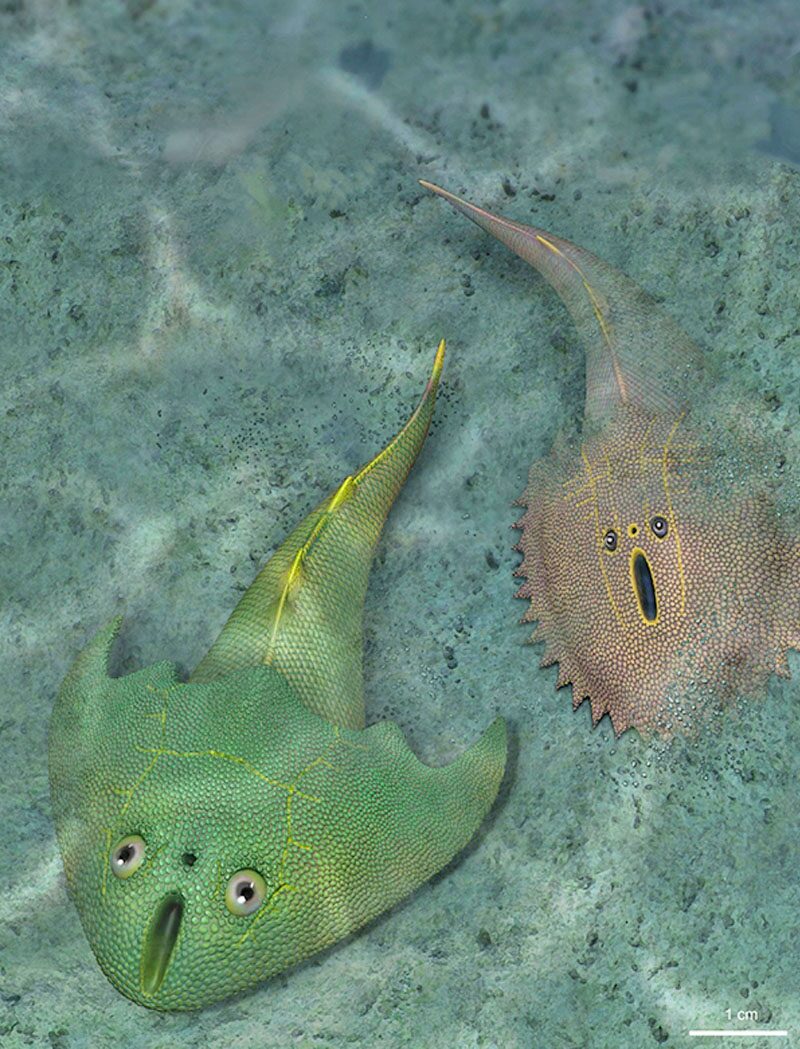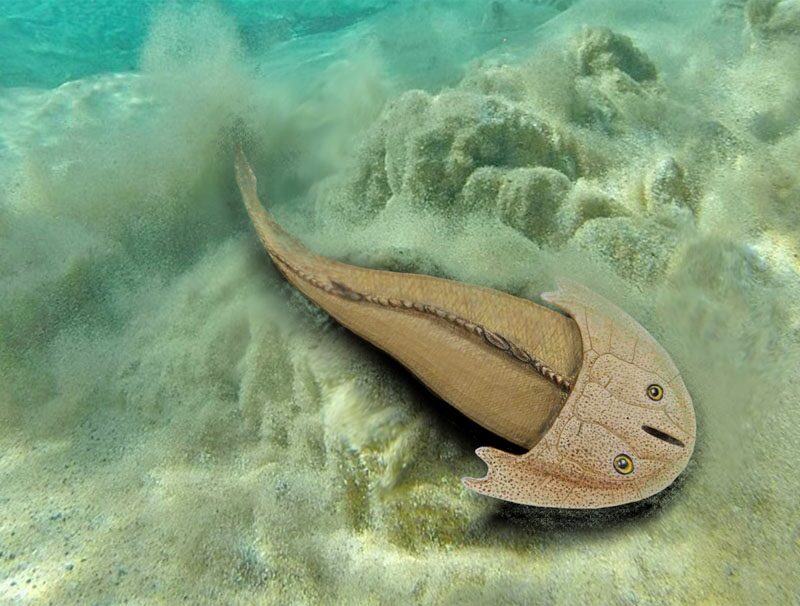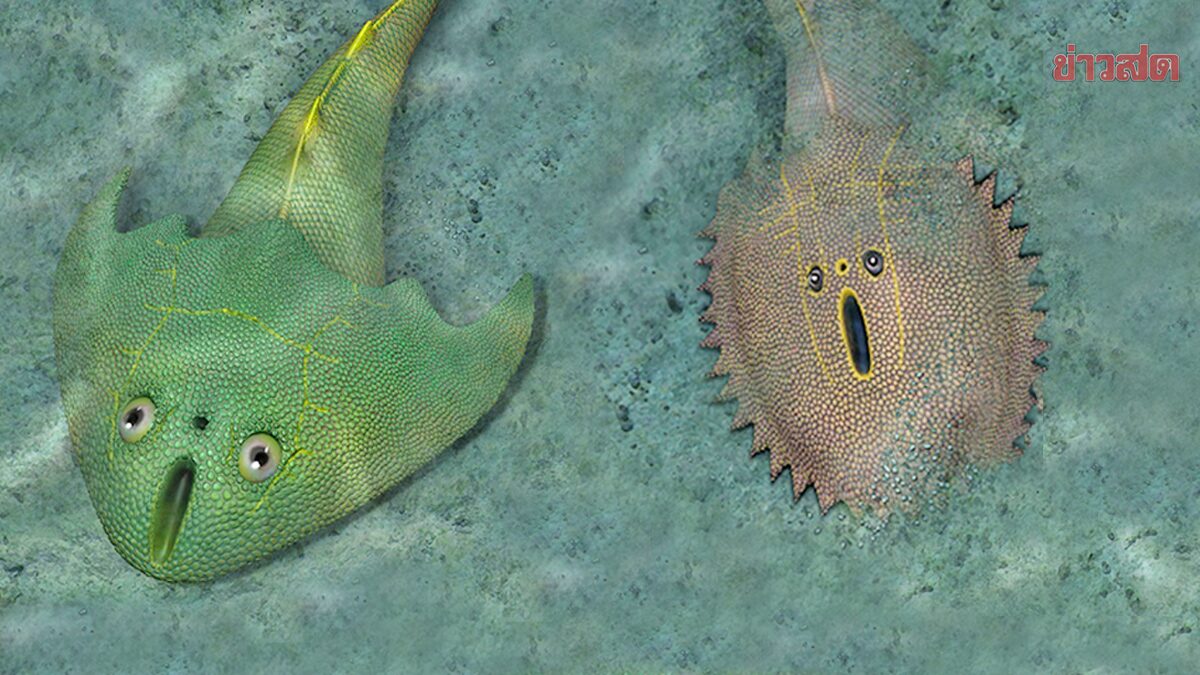พบฟอสซิลปลาโบราณ 2 สายพันธุ์ “หน้าคล้ายอีโมจิ” เก่าแก่กว่า 430 ล้านปี
พบฟอสซิลปลาโบราณ – ซินหัว รายงานว่าคณะนักวิจัยจีนค้นพบฟอสซิลปลาโบราณ 2 สายพันธุ์ ที่มีหน้าตาคล้าย “อีโมจิ” ในมณฑลเจียงซี ทางตะวันออกของประเทศ
บทความวิจัยที่เผยแพร่ผ่านวารสารเจอร์นัล ออฟ เอเชียน เอิร์ธ ไซแอนซ์ คาดการณ์ช่วงอายุของปลาข้างต้นว่าน่าจะอยู่ในยุคเทลีเคียนหรือช่วงเดียวกับหินตะกอนทะเลสีแดงยุคไซลูเรียนตอนล่าง ซึ่งมีอายุย้อนหลังไปราว 438 ล้านปี นับเป็นการค้นพบฟอสซิลปลาสายพันธุ์ ยูจาเลียสปิฟอร์ม (eugaleaspiform) ที่โบราณและเก่าแก่ที่สุดในปัจจุบัน

The photo shows the restored shapes of two ancient fish species. The fish age was estimated as early Telychian, or the Silurian Lower Red Beds, dating back about 438 million years, according to the research article recently published in the Journal of Asian Earth Sciences. The two new species, Qingshuiaspis junqingi and Anjiaspis ericius, were described from the lower Telychian Qingshui Formation in the province’s Wuning County. The finding represents the oldest and most primitive fossil record of the oldest eugaleaspiform fishes. (Provided by the researchers)
รายงานระบุว่าปลาสองสายพันธุ์ใหม่ดังกล่าว มีชื่อเรียกว่า “ชิงสุ่ยอัสปิส จวิ้นชิงกิ” (Qingshuiaspis junqingi) และ “อันจี๋อัสปิส เอริเชียส” (Anjiaspis ericius)
หินตะกอนทะเลสีแดงยุคไซลูเรียนตอนล่างกระจัดกระจายและพบได้ทั่วไปในภูมิภาคแยงซี โดยมีการดำเนินการศึกษาเป็นจำนวนมากเกี่ยวกับการลำดับชั้นหินตามชีวภาพ วิทยาหิน และตะกอนวิทยาของยุคไซลูเรียนตอนต้นในจีน
ขณะที่อายุทางธรณีวิทยาและความเกี่ยวโยงเชิงภูมิภาคของหินชนิดดังกล่าวในภูมิภาคยังคงเป็นที่ถกเถียง เนื่องจากการขาดหลักฐานฟอสซิลที่น่าเชื่อถือ
ผลการศึกษาข้างต้นซึ่งดำเนินการโดยคณะนักวิจัยจากสถาบันบรรพชีวินวิทยาสัตว์มีกระดูกสันหลังและมานุษยวิทยาบรรพกาล (ไอวีพีพี) สังกัดสถาบันวิทยาศาสตร์แห่งชาติจีน (ซีเอเอส) ถือเป็นหลักฐานฟอสซิลชิ้นสำคัญที่เกี่ยวโยงกับหินตะกอนทะเลสีแดงยุคไซลูเรียนตอนล่าง

ภาพประกอบ: Photo provided by Chongqing Municipal Bureau of Planning and Natural Resources shows the conceptual image of Yongdongaspis littoralis. The Silurian marine Lower Red Beds are widespread and well exposed in the Yangtze Region. Lots of works on the early Silurian biostratigraphy, lithology and sedimentology have been carried out in China, while the geological age and the regional correlation of the Silurian Lower Red Beds in the region remain contentious due to the absence of reliable fossil evidence. The study, conducted by researchers from the Institute of Vertebrate Paleontology and Paleoanthropology of the Chinese Academy of Sciences, provides important fossil evidence for the correlation of the Silurian Lower Red Beds. (Chongqing Municipal Bureau of Planning and Natural Resources/Handout via Xinhua)














